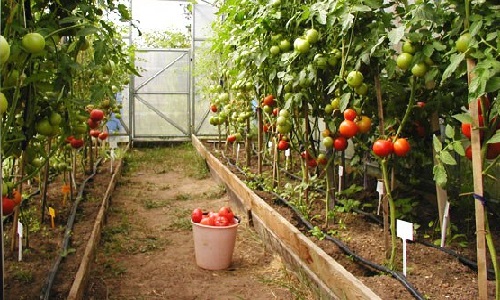 Growing tomatoes, including in a greenhouse, requires knowledge of many nuances. It is necessary to properly prepare the soil and plant seedlings in time, make every effort so that the tomatoes do not crack during growth and ripening. Therefore, it is important to know the tomatoes in the polycarbonate greenhouse: planting and care should be done correctly.
Growing tomatoes, including in a greenhouse, requires knowledge of many nuances. It is necessary to properly prepare the soil and plant seedlings in time, make every effort so that the tomatoes do not crack during growth and ripening. Therefore, it is important to know the tomatoes in the polycarbonate greenhouse: planting and care should be done correctly.
How to prepare a greenhouse
If the gardener installed a polycarbonate greenhouse on his plot, the amount of work to prepare it will be small in comparison with other types of greenhouses. It is necessary to wipe the walls, check how correctly the ventilation systems work after the winter. It's all.
Compared to the film construction, the polycarbonate greenhouse is perfect for tropless tomato growing. In film constructions, the difference between daytime and nighttime air temperatures at the end of spring will be felt. So, in many cases, the film will need to be insulated. At the same time, a distance of two centimeters must be left between the layers of the film: this will protect the structure from getting cold inside.
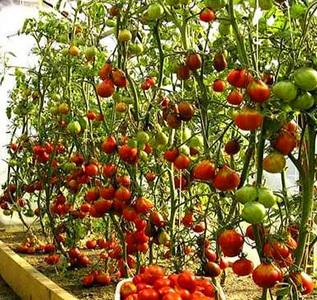
Important! If there is no ventilation system in the greenhouse, then you need to do it for the correct and successful cultivation of tomatoes of any kind. Tomatoes require high-quality and regular ventilation. The easiest way: organization of air vents on the sides and roof. Ventilation, even in conventional ventilation, significantly increase the yield of tomatoes.
Choosing the right soil
In polycarbonate greenhouses, as in any other types of greenhouses when growing tomatoes, the proper preparation of the soil will be a special point. The more fertile the soil will be, the plant will be able to grow faster and increase its productivity.
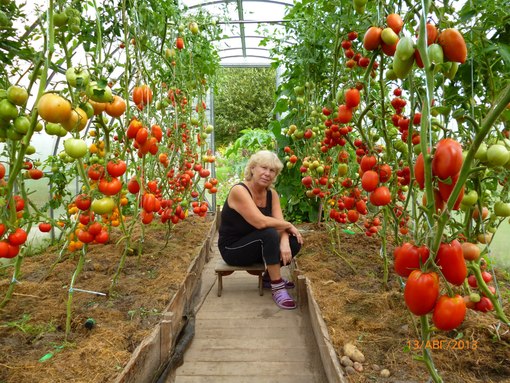
Soil preparation in the greenhouse begins with the removal of the top layer of 10 cm. Most often it is at this depth that spores of fungi and harmful microorganisms are located that can harm the growth of tomatoes. Further, the soil is disinfected, for which a solution of copper sulfate is used (for 10 liters of water, take a tablespoon of vitriol). If you consider a photo of tomatoes in a polycarbonate greenhouse (planting, care), you can pay attention that for normal flowering and fruiting it is necessary to add fertilizers to the soil.
What fertilizers for tomatoes to use in a polycarbonate greenhouse:
- With loamy, clay soil, peat and sawdust, humus are used. Additional components will make the earth quite loose, air will flow freely to the roots;
- Peat will need to be weighted with turf, sawdust or humus. You can add a little coarse sand;
- Chernozem also needs to be diluted, you can use sand or humus;
In addition to additives, the soil should be fertilized. You can use superphosphate, nitrate, wood ash.
When and how to plant seedlings
Seeds for seedlings are selected large and strong. In detail, how to grow good seedlings, we considered in a separate thematic article.
Important! For polycarbonate greenhouses, tomato seedlings need to be planted in late February or the first decade of March.
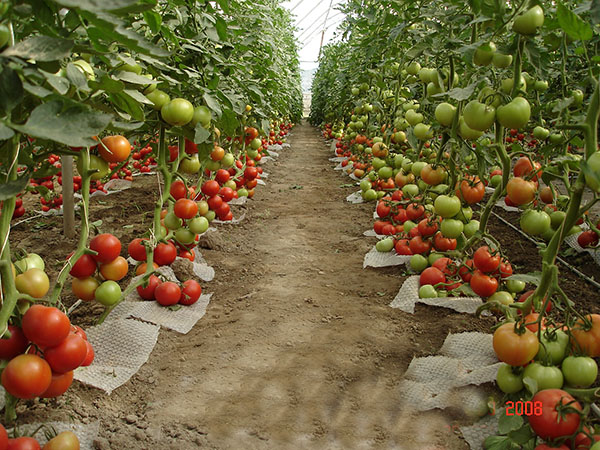
Seedlings must reach a height of 25 cm and age 60 days, so that it can be planted in greenhouse soil. If you hurry, you can harm the root system. The plant should be planted vertically, falling asleep to the first leaves. When the bush takes root, the hole can be sprinkled with earth.The first watering is carried out only 12 days after the planting of the plant in the greenhouse.
Important! Very carefully should be observed in the process of adaptation of seedlings for tall varieties. A distance of at least 60 cm must be left between the tomatoes. A tight planting will reduce the yield of each bush and prevent the plant from developing normally: it will simply not have enough space.
What care rules to follow:
- Timely watering;
- Pasynkovka if the selected grade requires it;
- Loosen the soil;
- Provide constant weeding;
- Tying;
- Timely application of fertilizer;
- Protection against diseases and pests;
If one would relate to one of the points given “through the sleeves”, then a good harvest can simply not be expected. If you make a drip irrigation system in a greenhouse, then the tomatoes will always receive a sufficient amount of moisture. As mulch, you can use straw, which will help to loosen and weed as rarely as possible.
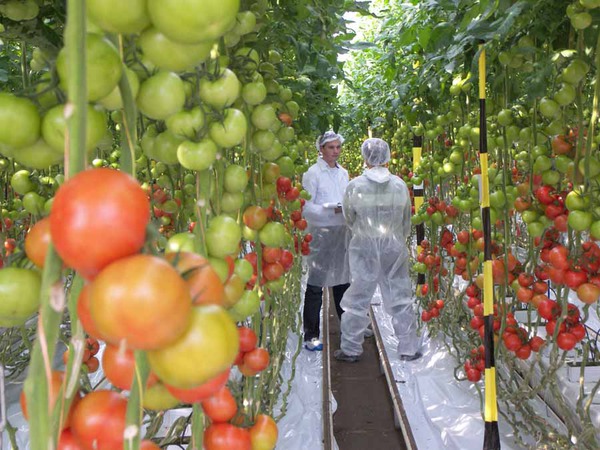
As for which tomatoes to plant in a polycarbonate greenhouse, you can choose any varieties for greenhouses. More information about this can be found on the pages of our site. For example, tomato varieties for greenhouses in the suburbs can be found in a large assortment and with a description in this article.
Growing tomatoes in a polycarbonate greenhouse is not as troublesome as in other types of greenhouses. But still, a structured approach and knowledge of the business is required. Then each bush will delight with the maximum number of ripe, tasty and beautiful fruits.




 Low-growing tomatoes, without pinching: 5 of the most delicious varieties
Low-growing tomatoes, without pinching: 5 of the most delicious varieties Why tomato seedlings grow poorly
Why tomato seedlings grow poorly We grow a tomato in a shell
We grow a tomato in a shell Growing tomatoes without watering according to the method of Kazarin
Growing tomatoes without watering according to the method of Kazarin
Diana
My father had a polycarbonate greenhouse, in my opinion it was called "Comet". So grown cucumbers and tomatoes. For some reason, the tomatoes did not get along, although they seemed to observe care. I read your article, everything is correct and useful, and we seemed to do just that, maybe it was just that the soil was not suitable, I had no idea ... But the crop is a pity (
Tatyana
It is believed that cucumbers and tomatoes need to be planted in different greenhouses. This is due to the fact that these crops need different conditions of detention (temperature, humidity of air and soil, fertilizers). So, for example, high humidity (which cucumbers are very fond of) is fatal for tomatoes. Humidity above 60% promotes the development of late blight, brown spotting, powdery mildew and gray rot in tomatoes. If the cucumbers were comfortable, then most likely the humidity was in the range of 85-90%.
Taisiya
Thanks for the advice, I will definitely consider them when planting tomatoes.